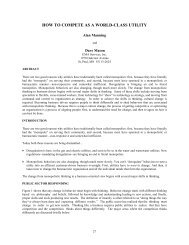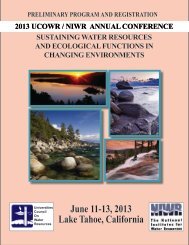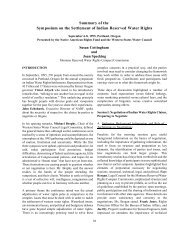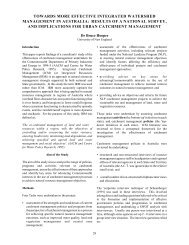38Hussey <strong>and</strong> Doversin water policy now is influenced by knowledge<strong>and</strong> constraints constructed in the past. Overall,Frawley’s (1994) overlapping stages in theenvironmental history <strong>of</strong> Australia can be seenunfolding—pioneering exploitation, wise use fornational development, modern environmentalism,<strong>and</strong> sustainable development—with as yetunresolved final results 1 .The original <strong>and</strong> most enduring watermanagement regime in Australia comprised finescale cultural <strong>and</strong> resource management practices<strong>of</strong> hundreds <strong>of</strong> indigenous nations <strong>and</strong> languagegroups, adapted to flexible livelihoods in a variableclimate. Although disrupted massively, the regimestill survives in practice, knowledge <strong>and</strong> law inparts <strong>of</strong> the continent. The recognition <strong>of</strong> nativetitles, return <strong>of</strong> indigenous people to the country <strong>and</strong>survival <strong>and</strong> resurrection <strong>of</strong> traditional knowledge<strong>and</strong> lifestyle have added indigenous values incurrent resource management debates (Baker etal. 2001, Jackson 2005), providing a backdrop <strong>of</strong>more than 50,000 years.European occupation <strong>of</strong> Australia from 1788saw the imposition <strong>of</strong> British water managementideas <strong>and</strong> rules. Growing underst<strong>and</strong>ing <strong>of</strong> a highlyvariable climate saw much experimentation <strong>and</strong>struggle, demonstrating the unsuitability <strong>of</strong> theBritish tradition <strong>of</strong> riparian rights. Led by Victorianpolitician <strong>and</strong> later Prime Minister Alfred Deakin<strong>and</strong> drawing lessons from domestic experience<strong>and</strong> international examples, Australia leading upto <strong>and</strong> at Federation in 1901 established a system<strong>of</strong> state control <strong>of</strong> water. The following shiftsnotwithst<strong>and</strong>ing, the system proved durable as aninstitutional framework for the following century.<strong>Water</strong> was a public good, managed through publicpolicy rather than the private sector. The states <strong>and</strong>territories, aided by Commonwealth money, workedto drive national development <strong>and</strong> agriculturalsettlement through public provision <strong>of</strong> irrigationinfrastructure <strong>and</strong> settlement schemes, culminatingin a massive dam-building exercise from the 1950-70s. The bulk <strong>of</strong> Australian water withdrawal was,<strong>and</strong> still is used in irrigated agriculture. <strong>Water</strong>allocation was volumetric, the costs <strong>of</strong> supplywere not recouped <strong>and</strong> technical improvementsin efficiency were rarely evident. In the cities,public works <strong>and</strong> water utility monopolies createda ‘‘big pipe in - big pipe out” system that achievedtremendous public health gains, but overlookedenvironmental <strong>and</strong> efficiency issues. In remotelocations, abstemiousness was the norm but by<strong>and</strong> large, water management was a matter <strong>of</strong>exp<strong>and</strong>ing supply, with dem<strong>and</strong> management <strong>and</strong>environmental considerations lagging far behind.The wise use movement in resource managementhad impacts on water management, but it wasthe questioning <strong>of</strong> a few economists, notablyDavidson (1969), <strong>of</strong> the costs <strong>and</strong> benefits <strong>of</strong>large works that called this trajectory to account,along with emerging environmental awareness.The global trend toward integration <strong>of</strong> water withl<strong>and</strong> <strong>and</strong> vegetation management showed notablyin Australia as integrated or total catchmentmanagement, with particular reference to what wasto become the headline issue <strong>of</strong> the 1980s to thepresent; salinity (Dore et al. 2003, Ewing 2003).That catchment scale focus has since evolved towhere major resource management programsare delivered largely through regional (mostlycatchment-defined) processes <strong>and</strong> organizations.Haphazard, drought-driven spasms <strong>of</strong> informationgathering <strong>and</strong> policy development came <strong>and</strong> wentfrom the 1960s on, with an international st<strong>and</strong>ardset with the institutional settings <strong>and</strong> informationcoordination <strong>of</strong> the Murray Darling Basin initiative.Community-based initiatives became widespreadin water <strong>and</strong> l<strong>and</strong> management, headlined bythe now famous Australian L<strong>and</strong>care movement(Curtis 2003). The era <strong>of</strong> sustainability from 1992 isknown in Australia as the ecologically sustainabledevelopment era. It emphasized in water aselsewhere, the emerging challenge <strong>of</strong> integratingenvironmental, social <strong>and</strong> economic dimensions innatural resource management. The mid-late 1990ssaw a National L<strong>and</strong> <strong>and</strong> <strong>Water</strong> Resources Auditconsolidate previous fits-<strong>and</strong>-starts in informationgathering episodes.However, it was not resource managementexperience or environmental concern that wasthe impetus for the biggest shift <strong>of</strong> all, buteconomic policy. Via the Council <strong>of</strong> AustralianGovernments, comprising the heads <strong>of</strong> Australianstate, territory <strong>and</strong> Commonwealth governments,economic efficiency <strong>and</strong> competitiveness becamethe most pervasive policy shift <strong>of</strong> recent decades.Supported by significant Commonwealth funding<strong>and</strong> intergovernmental agreements <strong>and</strong> schedules,UCOWRJOURNAL OF CONTEMPORARY WATER RESEARCH & EDUCATION
Trajectories in Australian <strong>Water</strong> Policy39National Competition Policy drove reform in manypolicy domains, <strong>and</strong> the “Council <strong>of</strong> AustralianGovernments water reforms” <strong>of</strong> the 1990s werea leading example. These reforms focused onproductivity, reduction <strong>of</strong> state subsidies, user-pays,separation <strong>of</strong> policy <strong>and</strong> provision, privatization<strong>and</strong> corporatization <strong>of</strong> functions, break-up to allowcompetition, use <strong>of</strong> market <strong>and</strong> property rightmechanisms <strong>and</strong> importantly, provision <strong>of</strong> flowsto the environment. As significant as they were,<strong>and</strong> underlined by severe early-1990s drought, theCouncil <strong>of</strong> Australian Governments water reformswere only a partial construction, <strong>and</strong> set thescene for the 2004-2014 National <strong>Water</strong> Initiativediscussed in the next section.We can identify a number <strong>of</strong> core imperatives<strong>and</strong> value-sets that have evolved at different times,yet co-exist in current policy debates <strong>and</strong> manifestin management experiments. While none areparticular to Australia, the combination perhapsis, especially in the context <strong>of</strong> extreme climatevariability <strong>and</strong> the specific constitutional <strong>and</strong> legalsystem.1. Security <strong>and</strong> predictability <strong>of</strong> water entitlementsfor consumptive users, in particular irrigatedagriculture. It is useful to separate two relatedyet different imperatives here, which at timesare conflated with ensuing confusion. Thefirst suggests public subsidy <strong>and</strong> long-termplanning; the latter the primacy <strong>of</strong> efficiency<strong>and</strong> market forces:• the social <strong>and</strong> equity imperative <strong>of</strong>maintaining water-dependent communities,established purposefully through previousgovernment policy; <strong>and</strong>• the economic imperative <strong>of</strong> productivity,competition in export trade, <strong>and</strong>efficiency in inputs, including <strong>of</strong> policyinterventions.2. Increasing prospects <strong>of</strong> water scarcity <strong>and</strong>the need for efficiency <strong>of</strong> use <strong>and</strong> changeto allocation rules, a product <strong>of</strong> increasedwithdrawal, greater number <strong>of</strong> water “users”(including environment), climate change<strong>and</strong> variability, <strong>and</strong> physical <strong>and</strong> economiclimitations to exp<strong>and</strong>ing supply.3. Widening <strong>of</strong> water policy <strong>and</strong> managementdebates to (i) create a “national” water policyarena, as opposed to several states or catchmentlimited arenas <strong>and</strong> (ii) greater awareness <strong>of</strong>urban <strong>and</strong> peri-urban as well as rural waterissues.4. An increasing role for catchment <strong>and</strong> regionalorganization <strong>and</strong> delivery <strong>of</strong> policy objectives,viewed as an efficient <strong>and</strong> suitable scale whereintegration <strong>of</strong> resource management canoccur.5. The importance <strong>of</strong> participatory approachesto resource management, at the catchment/regional scale but also at the local or “district”scale, through numerous programs epitomizedby L<strong>and</strong>care. The allowance <strong>of</strong> publicparticipation in higher order policy formulationis not so apparent.6. Ongoing efforts to rationalize or at leastcoordinate roles <strong>and</strong> responsibilities forresource management within a federal system.The main debates concern the Commonwealthversus state/territory powers, with the role <strong>of</strong>local government <strong>of</strong>ten ignored (Wild River2003).7. Increased emphasis on environmental waterflows, not simply in volume but also quality<strong>and</strong> timing <strong>of</strong> flows to maintain riverineecosystems. 28. Recognition <strong>of</strong> Indigenous water values <strong>and</strong>uses, encompassing environmental, cultural,subsistence, health, <strong>and</strong> economic developmentdimensions.9. As in all areas <strong>of</strong> public policy, changes inpolicy approaches <strong>and</strong> management styleswere strongly influenced by dominant neoliberalpolitical philosophy <strong>and</strong> neo-classicaleconomic theory, manifesting in the Australianterm “economic rationalism,” <strong>and</strong> managerialstyles termed New Public Management(McLaughlin et al. 2002).The following describes the National <strong>Water</strong>Initiative <strong>and</strong> the ways in which the above arereflected in it <strong>and</strong> interact in both synergistic <strong>and</strong>oppositional ways. We should note that consistentwith history, the formulation <strong>of</strong> the National <strong>Water</strong>Initiative coincided with severe drought from2001-04.The National <strong>Water</strong> InitiativeSigned in June 2004 3<strong>and</strong> building on theJOURNAL OF CONTEMPORARY WATER RESEARCH & EDUCATIONUCOWR
- Page 3: Journal of ContemporaryWater Resear
- Page 6 and 7: 2Bruce Hooperinstitutional, and tem
- Page 11 and 12: IWRM: Governance, Best Practice, an
- Page 13 and 14: IWRM: Defi nitions and Conceptual M
- Page 15 and 16: IWRM: Defi nitions and Conceptual M
- Page 17 and 18: IWRM: Defi nitions and Conceptual M
- Page 19: IWRM: Defi nitions and Conceptual M
- Page 22 and 23: 18Cardwell. Cole, Cartwright, and M
- Page 24 and 25: 20Mostert26 water boards responsibl
- Page 26 and 27: 22MostertTable 1. Third National Wa
- Page 28 and 29: 24MostertImplementationThe ambitiou
- Page 30 and 31: 26MostertBiswas, A. K. 2004b. Respo
- Page 32 and 33: 28UNIVERSITIES COUNCIL ON WATER RES
- Page 34 and 35: 30Ashton, Turton, and Rouxresource
- Page 36 and 37: 32Ashton, Turton, and Rouxassumptio
- Page 38 and 39: 34Ashton, Turton, and RouxEffective
- Page 40 and 41: 36UNIVERSITIES COUNCIL ON WATER RES
- Page 44 and 45: 40Hussey and Dovers1994 Council of
- Page 46 and 47: 42Hussey and Doversestablished Thes
- Page 48 and 49: 44Hussey and DoversTable 1. Typolog
- Page 50 and 51: 46Hussey and Doversassessment appro
- Page 52 and 53: 48Hussey and Doverspolicy goals.Bey
- Page 54 and 55: 50Hussey and DoversFrawley, K. 1994
- Page 56 and 57: 52Mitchelloften took three to four
- Page 58 and 59: 54Mitchelltree preservation plans;
- Page 60 and 61: 56UNIVERSITIES COUNCIL ON WATER RES
- Page 62 and 63: 58Genskow and Borna series of chall
- Page 64 and 65: 60Genskow and BornTable 1. Watershe
- Page 66 and 67: 62Genskow and Bornthe first Dungene
- Page 68 and 69: 64Genskow and BornWashington, DC.Ko
- Page 70 and 71: 66Green and Fernández-BilbaoWithin
- Page 72 and 73: 68Green and Fernández-Bilbaosubjec
- Page 74 and 75: 70Green and Fernández-Bilbaoinflue
- Page 76 and 77: 72Green and Fernández-BilbaoBerbel
- Page 78 and 79: 74UNIVERSITIES COUNCIL ON WATER RES
- Page 80 and 81: 76BallweberEstablish AdvisoryCommit
- Page 82 and 83: 78Ballweberattributes in others (Ch
- Page 84 and 85: 80UNIVERSITIES COUNCIL ON WATER RES
- Page 86 and 87: 82Barreiraand ground water. To this
- Page 88 and 89: 84Barreirawith other states for int
- Page 90 and 91: 86UNIVERSITIES COUNCIL ON WATER RES
- Page 92 and 93:
88Davis and ThrelfallResource Manag
- Page 94 and 95:
90Davis and ThrelfallTable 2. Thirt
- Page 96 and 97:
92Davis and Threlfallby regional an
- Page 98 and 99:
94Davis and Threlfallenforcement, a
- Page 100 and 101:
96Davis and Threlfallhusbandry prac
- Page 102 and 103:
98Davis and ThrelfallNew Zealand: T
- Page 104 and 105:
100UNIVERSITIES COUNCIL ON WATER RE
- Page 106 and 107:
102Lamoree and van SteenbergenIt is
- Page 108 and 109:
104Lamoree and van Steenbergenand n
- Page 110 and 111:
106Lamoree and van Steenbergeninter
- Page 112 and 113:
108BourgetWorks Planner Capability
- Page 114 and 115:
110Bourgetwith over 600 people resp
- Page 116 and 117:
112Bourgetgovernment’s intrusion
- Page 118 and 119:
114Bourget4.management, drought man
- Page 120 and 121:
116McKayFigure 1. The four paradigm
- Page 122 and 123:
118McKay4. Paradigm 4 (which commen
- Page 124 and 125:
120McKaythree main functions:1. ass
- Page 126 and 127:
122McKayState Implementation of the
- Page 128 and 129:
124McKayTable 2. Corporate governan
- Page 130 and 131:
126McKayFigure 4. Qu. 26 - The ESD
- Page 132 and 133:
128McKayFigure 7. Qu.93- This organ
- Page 134 and 135:
130McKayBrundtland Report. 1987. Ou
- Page 136 and 137:
132UCOWR BOARD OF DIRECTORS/COMMITT
- Page 138 and 139:
134BENEFITS OF UCOWR MEMBERSHIPThe
- Page 140 and 141:
136Past Issues of the Journal of Co
- Page 142 and 143:
138Academic Organizations Membershi
- Page 144 and 145:
140Individual Membership Applicatio
- Page 146 and 147:
Universities Council on Water Resou
- Page 148:
Integrated Water Resources Manageme








